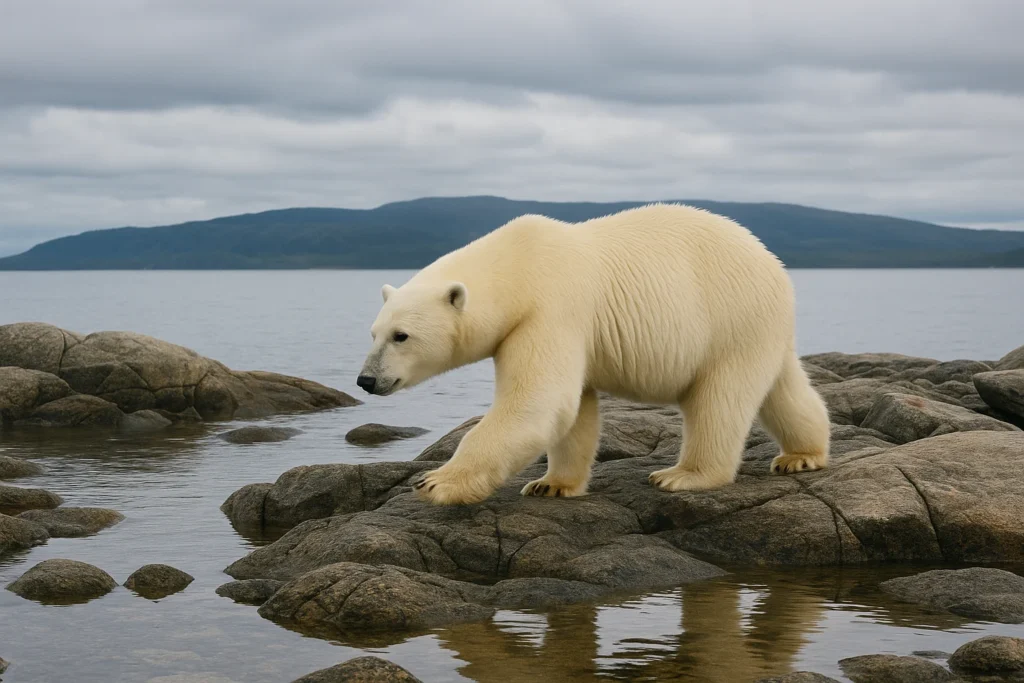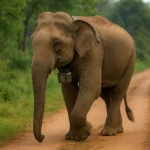The Arctic, a land of vast, glittering ice and boundless snow, has long been the iconic stronghold of the polar bear. These magnificent predators, perfectly adapted to their frozen world, embody the wild spirit of the far north. Yet, a silent, profound crisis is unfolding in their pristine habitat. As the planet warms and the Arctic ice melts at an alarming rate, polar bears are being pushed out of their ancestral homes, becoming, in essence, the world’s first climate refugees among wild animals. Their desperate search for food and stable ice is leading them into increasingly unusual and dangerous territories, offering a stark visual warning of a planet in turmoil.
Imagine seeing a polar bear, an animal synonymous with the high Arctic, wandering far south in places like Newfoundland or near the shores of northern Scotland. While the idea might seem like something out of a fictional tale, such sightings, though rare and often isolated incidents, are becoming a chilling reality. They serve as poignant reminders that the impacts of climate change are not confined to distant scientific reports but are visibly reshaping the natural world, forcing its inhabitants to adapt or perish.
The Arctic Under Siege: A Melting Home
For polar bears, sea ice is not just a platform; it’s their entire world. It’s where they hunt seals, their primary food source, ambushing them at breathing holes or on the ice surface. It’s where they travel, breed, and raise their cubs. Without stable, extensive sea ice, their survival becomes incredibly difficult.
The Arctic is warming at a rate nearly four times faster than the rest of the globe. This rapid temperature increase is causing the crucial sea ice to melt earlier in the spring and freeze later in the fall. This means polar bears have less time to hunt and build up the fat reserves they need to survive the leaner summer months when they often fast on land. Longer ice-free periods force them to spend more time ashore, often far from their traditional hunting grounds, leading to reduced access to food, decreased body condition, and lower reproductive rates. In some populations, scientists have observed significant declines directly linked to this loss of sea ice.
Uncharted Waters: Sightings in Unusual Places
As their icy hunting grounds disappear, some polar bears are driven by hunger and desperation to explore new, unfamiliar areas in search of sustenance. This can lead to extraordinary and concerning sightings far outside their typical range:
- Newfoundland and Labrador: While polar bears are native to parts of Labrador and occasionally drift to the island of Newfoundland on spring ice, sightings in communities and further south have become more common in recent years. These occurrences are often linked to bears drifting on ice floes from the melting Arctic, sometimes ending up disoriented and stranded on land. Local authorities frequently issue warnings and advise residents on how to act if they encounter a bear.
- Northern Scotland (Historical Context): While there have been occasional (and sometimes exaggerated) reports, it’s important to note that direct sightings of wild polar bears in northern Scotland are largely historical or anecdotal, often linked to bears brought in via whaling ships, or even April Fool’s jokes. However, the discussions about potential future sightings underscore the very real concern that as the Arctic ice recedes, the possibility of such desperate journeys increases. The mere contemplation of a polar bear in Scotland highlights the dramatic shift in perceptions about climate change’s reach.
- Russia’s Far East and Iceland: Beyond the immediate North Atlantic, polar bears have also been sighted in unusual locations further south in Russia’s far eastern regions, sometimes hundreds of kilometers inland from the coast, driven by unstable ice conditions in the Bering and Chukchi Seas. Similarly, occasional sightings have occurred in Iceland, often involving bears that have drifted from Greenland on ice floes, reminding the world of their plight.
These “climate refugee” journeys are often fraught with danger for the bears, as they struggle to find food and cope with unfamiliar environments. Sadly, many of these encounters with human populations end tragically for the bears, due to safety concerns.
The Ripple Effect: Beyond the Bears
The plight of the polar bear is a powerful symbol, but it’s also a stark warning. As the Arctic ecosystem undergoes radical transformation, the ripple effects are felt throughout the global climate system and impact other species as well.
- Ecosystem Collapse: The loss of sea ice doesn’t just affect polar bears; it impacts the entire Arctic food web, from the algae that grow on the ice to the seals that feed on them. This disruption threatens the balance of a fragile and interconnected ecosystem.
- Global Climate Regulation: The Arctic acts as the Earth’s “air conditioner,” reflecting sunlight back into space. As more ice melts, darker ocean water absorbs more heat, accelerating global warming. This feedback loop has far-reaching consequences for weather patterns and sea levels worldwide.
- Indigenous Communities: Arctic Indigenous communities, who have coexisted with polar bears for millennia, are also profoundly affected. Their traditional way of life, tied to the ice and its animals, is being irrevocably altered by climate change.
The unusual journeys of polar bears are not isolated incidents but symptoms of a much larger, systemic problem that demands global attention and urgent action.
A Call to Action: Safeguarding a Frozen Future
The story of the polar bear, the ultimate symbol of the wild Arctic, is a dramatic illustration of the direct consequences of climate change. Their desperation, visible in their southward movements, serves as an urgent call to action.
Efforts to protect polar bears and their habitat require a multi-faceted approach:
- Rapid Emissions Reduction: The most critical step is a drastic and immediate reduction in global greenhouse gas emissions to slow down Arctic warming and stabilize sea ice. This means a swift transition to renewable energy sources and sustainable practices worldwide.
- Habitat Protection: Safeguarding critical polar bear habitats, including key denning areas and remaining stable ice regions (sometimes referred to as “Last Ice Areas”), is crucial for their long-term survival.
- International Cooperation: Polar bears roam across multiple countries’ territories. Effective conservation requires strong international collaboration and shared management strategies.
- Research and Monitoring: Continued scientific research into polar bear populations, their movements, and their physiological responses to a changing environment is vital for informed conservation decisions.
The sight of a polar bear in a place it shouldn’t be is more than just a rare event; it’s a poignant message from the front lines of climate change. These magnificent creatures are navigating a rapidly transforming world, and their fate rests on humanity’s ability to respond with the urgency and commitment that this global crisis demands. Protecting them means protecting the delicate balance of our entire planet.



